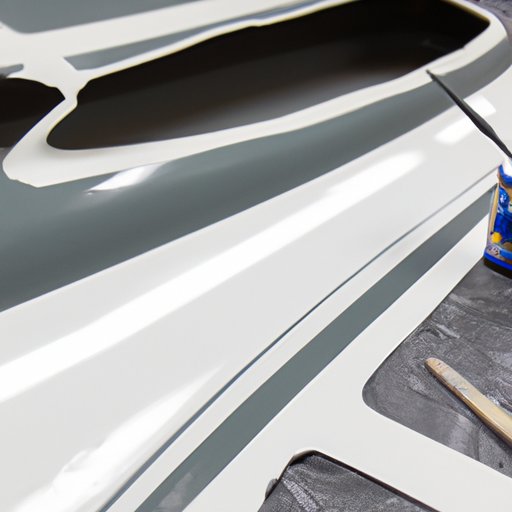Introduction
If you’re looking to give your car a makeover or simply want to fix minor scratches and dents, painting your car at home can be a cost-effective and rewarding DIY project. This article is intended for car enthusiasts and anyone interested in repainting their car at home. With a bit of patience and the right tools and techniques, you can achieve a professional-looking finish that will make your car stand out.
Step-by-Step Guide
Painting your car at home requires careful planning and attention to detail. Here are the basic steps to follow:
Car preparation:
Before painting your car, it is crucial to prep your car adequately. This includes washing your car to remove any dirt and contaminants that might interfere with the paint’s adhesion. Sanding your car’s surface with the sandpaper to remove the top layer of paint. You can use a rust converter to get rid of rust on the metal surfaces.
Choosing the right paint:
Choosing the right paint is vital to the success of your car painting project. You will need to choose a paint system that has primer, base coat, and clear coat. Select a paint color and finish that match your car’s existing color or choose a new color for a different look.
Applying the paint:
The correct technique to apply the paint involves spraying or rolling, depending on the car’s size and shape. Spraying is the most common method. Use an air compressor and paint gun to apply several coats of the paint, allowing each coat to dry before applying the next.
Drying and curing:
After applying the paint, allow it to dry for at least 24 hours. The drying time depends on the type of paint and the weather conditions. Curing time can take up to 30 days. Avoid washing the car or exposing it to any harsh weather conditions during this time.
Equipment and Materials
Painting your car requires specific tools and materials for a successful project. Here are some of the essential equipment and materials you will need:
Paint guns:
To apply the paint on your car, you will need a quality paint gun. Selecting the right paint gun will depend on your experience and preference.
Air compressors:
Air compressors are necessary to power the paint gun, allowing it to spray the paint onto the surface evenly.
Sandpaper:
Sandpaper is necessary to remove any rough spots, minor scratches, and rust on your car’s surface before painting.
Masking tape:
To protect areas of your car that do not require painting, use masking tape to cover the areas you do not want to paint.
Primer, base coat, and clear coat:
Choose a paint system that has primer, base coat, and clear coat specifically designed for cars. These paints come in a range of colors and finishes, including matte, metallic, and glossy.
Safety equipment:
Be sure to have safety gear on hand, including a respirator, goggles, gloves, and a dust mask.
Safety Tips
Safety should always be a priority when painting your car at home. Consider these safety tips:
Using proper ventilation:
Paint produces fumes that can be hazardous to your health. Ensure that you have proper ventilation in your workspace, and always work with windows open or use a good ventilation system.
Wearing appropriate safety gear:
Wear a protective mask, goggles, gloves, and clothing that covers your entire body when applying paint and handling chemicals.
Keeping the workspace clean and organized:
Work in a clean and well-organized area to avoid accidental spills or accidents.
Handling chemicals properly:
Handle chemicals responsibly, and always follow the manufacturer’s instructions.
DIY vs Professional Painting
You might wonder whether to repaint your car yourself or hire a professional. Here are some pros and cons:
Cost:
Painting your car yourself is significantly less expensive than hiring a professional.
Time:
Repainting your car at home is a time-consuming task. It can take up to a week, depending on your experience and the scope of the project. Hiring a professional can reduce this time, but it is important to factor in the additional costs.
Quality of the final product:
Hiring a professional will produce a quality product with fewer errors than doing it yourself. The professional has the experience, expertise, and tools to create a professional-looking finish.
Tips and Tricks for a Professional-Looking Finish
Here are some tips to help you ensure a professional-looking finish:
Avoiding common mistakes:
Avoiding runs, drips, and overspray can help you achieve a flawless finish. Be sure to apply even coats with the right pressure to avoid any mistakes.
Choosing the right paint color and finish:
Choosing the right color and finish that matches your car’s look can help you achieve a professional-looking finish.
Applying clear coat correctly:
Clear coat seals the paint and gives it a glossy look. Applying the clear coat correctly, without runs or streaks, is crucial to achieving a professional finish.
Video Tutorials
Watching video tutorials can help you gain more insights and expertise on how to paint your car at home. Here are some helpful video tutorials:
https://www.youtube.com/watch?v=uPzpEYtJ-Fk
https://www.youtube.com/watch?v=3DxI-uBM-Sw>
Conclusion
Painting your car at home is a rewarding project that can save you money and give your car a new look. With patience, attention to detail, and the right tools and techniques, you can achieve a professional-looking finish. Be sure to follow all safety tips and guidelines and use quality equipment and materials.
(Note: Is this article not meeting your expectations? Do you have knowledge or insights to share? Unlock new opportunities and expand your reach by joining our authors team. Click Registration to join us and share your expertise with our readers.)
